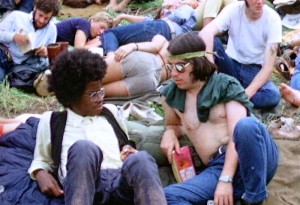Ebony magazine was on the scene in San Francisco in 1967 to turn out a good Summer of Love article, “The Hippies of Hashberry: A New Generation Flees Fabled American Dream.” There was, naturally, an African-American angle to part of Charles E. Brown’s piece, which explained that the hippies were more taken with Native American culture than the Beats, who were influenced by black culture. But most of the report looked at hippiedom in a broader context. An excerpt:
“A residential neighborhood just south of San Francisco’s Golden Gate Park is probably where it all began. The steepled rooftops of Haight-Ashbury’s Victorian homes were once the mark of middle-class respectability. Three years ago the hippies converged and christened the place Hashberry. Now, as the ‘squares’ depart to resume ‘more orderly’ lives, the hippies come in larger numbers, mostly in the summer…They come to Haight-Ashbury to be ‘where it’s at.’
‘But they carry lice and venereal disease wherever they go,’ a Haight Street realtor complains. ‘They’re a dirty, immoral bunch.’ His views are seconded by most people in authority–certainly the police in nearly every city in America.
There are those, like Episcopalian minister Malcolm Boyd, who see them in a different light: as young men and women in search of an honest morality, a morality that is foreign to middle-class Americans. ‘This is a time of great social ferment,’ says the Rev. Mr. Boyd, ‘and very little is being swept under the rug…the people who appear to be copping out–the hippies–are making serious contributions…while some who pose as liberals are not.'”

